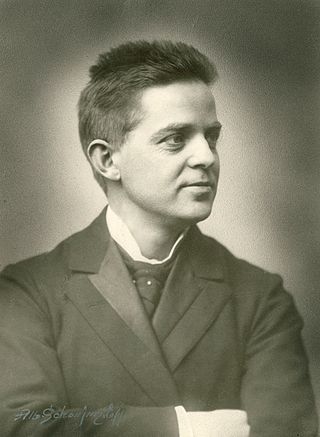
Carl August Nielsen was a Danish composer, conductor, and violinist, widely recognized as his country's most prominent composer.

The earliest traces of Danish music go back to the many twisting Bronze-Age horns or lurs which some experts have identified as musical instruments. They have been discovered in various parts of Scandinavia, mostly Denmark, since the end of the 18th century. Denmark's most famous classical composer is Carl Nielsen, especially remembered for his six symphonies, while the Royal Danish Ballet specializes in the work of Danish choreographer August Bournonville. Danes have distinguished themselves as jazz musicians, and the Copenhagen Jazz Festival has acquired an international reputation. The modern pop and rock scene has produced a few names of note, including MØ, Dizzy Mizz Lizzy, Lukas Graham, D-A-D, Tina Dico, Aqua, The Raveonettes, Michael Learns to Rock, Volbeat, Alphabeat, Safri Duo, Medina, Oh Land, Kashmir, King Diamond, Outlandish, and Mew. Lars Ulrich is the first Danish musician to be inducted into the Rock and Roll Hall of Fame.

Niels Wilhelm Gade was a Danish composer, conductor, violinist, organist and teacher. Together with Johan Peter Emilius Hartmann, he was the leading Danish musician of his day, in the period known as the Danish Golden Age.

Rued Langgaard was a late-Romantic Danish composer and organist. His then-unconventional music was at odds with that of his Danish contemporaries but was recognized 16 years after his death.
Symphony No. 4, Op. 29, FS 76, also known as "The Inextinguishable", was completed by Danish composer Carl Nielsen in 1916. Composed against the backdrop of World War I, this symphony is among the most dramatic that Nielsen wrote, featuring a "battle" between two sets of timpani.

Otto Valdemar Malling was a Danish composer, from 1900 the cathedral organist in Copenhagen and from 1889 professor, then from 1899 Director of the Royal Danish Academy of Music, Copenhagen.

The Danish composer Carl Nielsen wrote his Symphony No. 3 "Sinfonia Espansiva", Op. 27, FS 60, between 1910 and 1911. Around 35 minutes in length, it is unique in his symphonic output for having vocal parts, specifically wordless solos for soprano and baritone in the second movement.
Symphony No. 1 in G minor, Op. 7, FS 16, is the first symphony of Danish composer Carl Nielsen. Written between 1891 and 1892, it was dedicated to his wife, Anne Marie Carl-Nielsen. The work's première, on 14 March 1894, was performed by Johan Svendsen conducting the Chapel Royal Orchestra, with Nielsen himself among the second violins. It is one of two symphonies by Nielsen without a subtitle.

Johan Peter Emilius Hartmann was, together with his son-in-law Niels W. Gade, the leading Danish composer of the 19th century, a period known as the Danish Golden Age. According to Alfred Einstein, he was "the real founder of the Romantic movement in Denmark and even in all Scandinavia". J.P.E. Hartmann was the third generation of composers in the Danish musical Hartmann family.
Franz Adolf Syberg was a Danish composer.

Mogens Wöldike was a Danish conductor, choirmaster, organist, and scholar known for his interpretation of music from the Baroque and Classical periods, was born and died in Copenhagen. His son-in-law was the Haydn scholar Jens Peter Larsen. He studied under Carl Nielsen and Thomas Laub and graduated from Copenhagen University in 1920. He was organist at the Marine church in 1924 and the Christiansborg Palace Church from 1931; from 1959 to 1972 he was organist at Copenhagen Cathedral.

Carl Nielsen's Helios Overture, Opus 17, is a concert overture which was first performed by the Royal Danish Orchestra, conducted by Johan Svendsen, on 8 October 1903 in the large hall of the Odd Fellows Mansion in Copenhagen.
Emilius Bangert was a Danish composer, organist, and professor. He played the organ at Roskilde Cathedral and also composed orchestral and chamber music.

Johann Ernst Hartmann was a Danish classical composer and violinist. He is remembered in particular for his two operas on texts by Johannes Ewald in which he helped creating a national musical style. The first of these, Balders død, builds on the old Nordic mythology and uses dark colours when depicting the old Gods and Valkyries. The second, Fiskerne, describes contemporary fishermen’s lives, and uses melodies inspired by the Scandinavian folk style.
Jakob Lorentzen is a Danish organ soloist and chamber musician. He is organist and choir master of the Holmen Church and Master of the music at Christiansborg Palace Chapel, both principal churches in the Copenhagen city.
Carl Nielsen's Chaconne, Op. 32, is among the composer's most frequently played compositions for piano.
Pan and Syrinx, Op. 49, is a symphonic poem for orchestra written in 1918 by the Danish composer Carl Nielsen. The piece received its premiere in Copenhagen on 11 February 1918.

Musikforeningen in Copenhagen was Denmark's most important concert venue in the 19th century. It operated from 1838 to 1931 but it was especially under the leadership of Niels Gade (1850–90) that it became a meeting place for the city's music life with its own symphony orchestra and choir. Carl Nielsen was director from 1915–27. Other leaders included Franz Gläser, Emil Hartmann and Franz Neruda.
Events from the year 1883 in Denmark.










